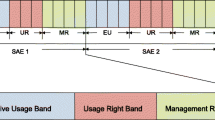Abstract
Dynamic spectrum management makes it possible for the owner of usage rights on some frequency blocks to sublet each of them in real time and for a limited period of time. As a softer implementation with respect to the spot market a two stage assignment is here proposed through the use of options, which give buyers the right to purchase the usage right on a single block and for a timeslot. In the sale of options the primary owner may accomplish an overbooking strategy, which consists in selling more blocks than the available ones, and acts as a hedging tool against the risk of unsold blocks. A model for the overbooking strategy is described and evaluated, which takes into account both the value of the option, the correlated decisions taken by the prospective purchasers, and the penalty to be paid to the unsatisfied customers. The dependence of the economical convenience of the overbooking strategy on the relevant parameters (among which the penalty value and the overbooking ratio) is shown for a significant range of cases.
Similar content being viewed by others
References
Alleman, J. (2002). A new view of telecommunications economics. Telecommunications Policy, 26(1–2), 87–92.
Analysys (2004). Study on conditions and options in introducing secondary trading of radio spectrum in the European Community. Final Report for the European Commission, Analysis Consulting.
Bae, J., Beigman, E., Berry, R., Honig, M., Shen, H., Vohra, R., & Zhou, H. (2008). Spectrum markets for wireless services. In 3rd IEEE symposium on new frontiers in dynamic spectrum access networks DySPAN 2008 (pp. 1–10). Chicago.
Börgers, T., & Dustmann, C. (2003). Awarding telecom licences: the recent European experience. Economic Policy, 18, 215–268.
Cave, M. (2002). Radio spectrum management (Review).
De Vany, A. (1998). Implementing a market-based spectrum policy. Journal of Law & Economics, 41, 627–646.
De Vany, A., Eckert, R., Meyers, C., O’Hara, D., & Scott, R. (1969). A property system for market allocation of the electromagnetic spectrum: a legal-economic-engineering study. Stanford Law Review, 21, 1499–1561.
d’Halluin, Y., Forsyth, P., & Vetzal, K. (2002). Managing capacity for telecommunications networks under uncertainty. IEEE/ACM Transactions on Networking, 10, 579–588.
Doyle, L., & Forde, T. (2007). Towards a fluid spectrum market for exclusive usage rights. In 2nd IEEE symposium on new frontiers in dynamic spectrum access networks DySPAN 2007 (pp. 620–632). Dublin.
Foster, A. (2006). Introducing spectrum trading. In Executive level training for regulators and policy-makers. Hong Kong.
Glasserman, P., & Li, J. (2003). Importance sampling for portfolio credit risk. Management Science, 51, 1643–1656.
Glover, W., & Nekovee, M. (2007). Dynamic spectrum: going the full circle. In 2nd IEEE symposium on new frontiers in dynamic spectrum access networks DySPAN 2007. Dublin.
Gruber, H. (2006). 3G mobile telecommunications licenses in Europe: a critical review. Preprint No. 918003, SSRN.
Harmantzis, F., & Tanguturi, V. (2004). Delay in the expansion from 2.5G to 3G wireless networks: a real options approach. In International telecommunications society 15th biennial conference. Berlin.
Harmantzis, F., & Tanguturi, V. (2004). Real options analysis for GPRS network with Wi-Fi integration. In 31st annual conference of the Northeast Business & Economics Association. New York.
Harmantzis, F., & Tanguturi, V. (2007). Investment decisions in the wireless industry applying real options. Telecommunications Policy, 31, 107–123.
Hull, J. (2008). Options, futures, and other derivatives (7th edn.). New York: Prentice Hall.
Kalmus, P. (2004). Wireless local loop lessons from the US (Technical Report). NERA.
Kasilingam, R. (1997). An economic model for air cargo overbooking under stochastic capacity. Computers Industrial Engineering, 32(1), 221–226.
Kenyon, C., & Cheliotis, G. (2001). Stochastic models for telecom commodity prices. Computer Networks, 36(5/6), 533–555.
Li, X. Y., Xu, P., Tang, S., & Chu, X. (2008). Spectrum bidding in wireless networks and related. In COCOON ’08: Proceedings of the 14th annual international conference on computing and combinatorics (pp. 558–567). Berlin: Springer.
Lichtenberger, E. (2003). Spectrum trading in Germany, Austria and the UK: the influence of regulatory regimes and evaluation of criteria on competition in the European mobile telecommunication sector. In ITS conference. Helsinki.
Martino, M. (2004). Main regulatory issues in the market for mobile networks and services and in frequency assignment (in Italian). In AGCOM study seminar. Anacapri.
Mastroeni, L., & Naldi, M. (2009). A real options model for the transferability value of telecommunications licenses. Annals of Telecommunications. Accepted for publication.
Merton, R., Scholes, M., & Gladstein, M. (1978). The returns and risk of alternative call option portfolio investment strategies. The Journal of Business, 51(2), 183–242.
Northstream (2002). 3G rollout status (Report PTS-ER-2002:22).
Ofcom (2004). A statement on spectrum trading: implementation in 2004 and beyond.
Pogorel, G. (2003). Radio spectrum policy and management: a turning point? Communications & Strategies 109–117.
Radiocommunications Agency (2002). Implementing spectrum trading.
Sklar, B. (2001). Digital communications. New York: Prentice Hall.
Stine, J. (2006). Enabling secondary spectrum markets using ad hoc and mesh networking protocols. Journal of Communications, 1(1), 26–37.
Suzuki, Y. (2002). An empirical analysis of the optimal overbooking policies for US major airlines. Transportation Research Part E, 38, 135–149.
Tasaka, S. (1986). Performance analysis of multiple access protocols. Cambridge: MIT Press.
Valletti, T. (2001). Spectrum trading. Telecommunications Policy, 30, 655–670.
Whalley, J., & Curwen, P. (2006). Third generation new entrants in the European mobile telecommunications industry. Telecommunications Policy, 30, 622–632.
Author information
Authors and Affiliations
Corresponding author
Rights and permissions
About this article
Cite this article
Mastroeni, L., Naldi, M. Options and overbooking strategy in the management of wireless spectrum. Telecommun Syst 48, 31–42 (2011). https://doi.org/10.1007/s11235-010-9332-0
Published:
Issue Date:
DOI: https://doi.org/10.1007/s11235-010-9332-0




